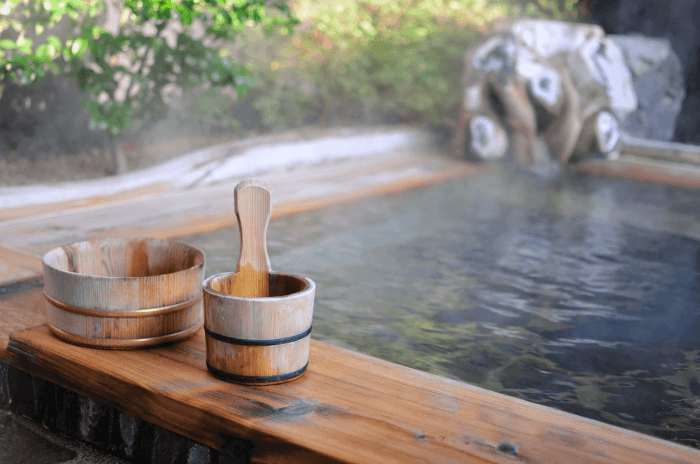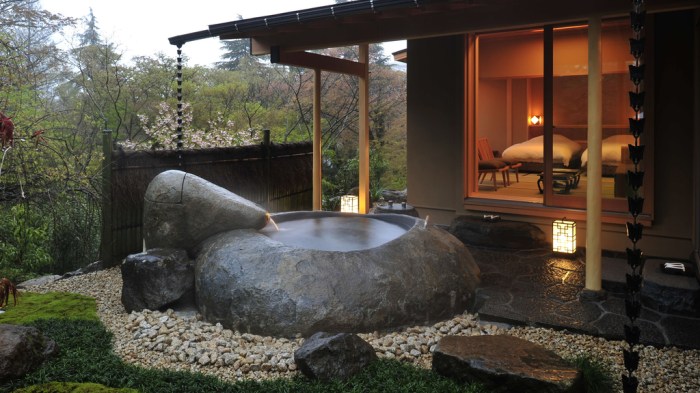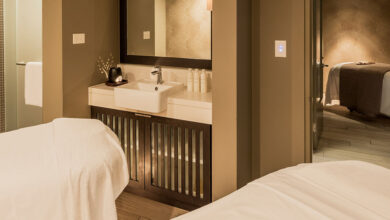Kyoto Ryokans Culture, Onsen, and Tradition
Traditional Ryokans in Kyoto with cultural experiences and onsen baths offer a unique and immersive journey into Japan’s rich heritage. Imagine yourself stepping into a world of serene gardens, tatami mats, and the soothing warmth of an onsen after a day exploring ancient temples and bustling markets. These traditional Japanese inns provide more than just accommodation; they offer a complete cultural experience, blending historical significance with modern comforts.
From participating in a traditional tea ceremony to learning the art of calligraphy, a stay in a Kyoto Ryokan promises an unforgettable escape.
This exploration delves into the history and architecture of Ryokans, the diverse cultural activities they offer, and the rejuvenating experience of onsen bathing. We’ll compare different types of Ryokans, helping you plan your ideal trip, and share tips for booking and maximizing your experience. Prepare to be captivated by the sights, sounds, and scents of a truly authentic Kyoto adventure.
Introduction to Traditional Ryokans in Kyoto
Kyoto’s ryokans represent more than just places to stay; they are living embodiments of Japan’s rich history and culture. These traditional inns offer a unique glimpse into the country’s past, providing a deeply immersive and authentic experience for travelers seeking something beyond the typical hotel stay. Their evolution mirrors Kyoto’s own, reflecting centuries of artistic and social change.Ryokans have played a vital role in Kyoto’s history, serving as resting places for travelers along ancient trade routes and as venues for social gatherings and artistic expression.
From humble beginnings, they have evolved into sophisticated establishments, often frequented by royalty, nobility, and artists throughout various periods of Japanese history. Their enduring presence speaks to their ability to adapt while maintaining their core values of hospitality and cultural preservation.
Architectural Features of Traditional Ryokans
Traditional Kyoto ryokans are characterized by their distinct architectural style, often featuring tatami mat floors, shoji screens (sliding doors made of translucent paper), and fusuma (sliding doors made of wood or paper). These elements not only create a calming and serene atmosphere but also reflect traditional Japanese aesthetics, emphasizing natural materials and a connection to the surrounding environment. The use of wood, often polished to a high sheen, contributes to the warmth and elegance of the interior spaces.
Many ryokans incorporate traditional Japanese gardens, offering guests a tranquil space for contemplation and relaxation. The design often prioritizes natural light and the integration of outdoor elements, blurring the lines between inside and outside. Specific features may vary, but the overall effect is one of understated elegance and refined simplicity.
Amenities and Services Offered in Kyoto Ryokans
Beyond their aesthetic appeal, Kyoto ryokans offer a range of amenities and services designed to enhance the guest experience. These typically include traditional Japanese meals (kaiseki), often featuring seasonal ingredients and meticulously prepared dishes. The emphasis is on both presentation and taste, creating a culinary journey alongside the cultural immersion. Many ryokans also offer onsen (hot spring baths), providing a relaxing and rejuvenating experience.
These baths, often featuring both indoor and outdoor options, are considered an integral part of the ryokan experience. Other common amenities include yukata (light cotton kimonos) for guests to wear during their stay, comfortable futons (traditional Japanese mattresses) for sleeping on the tatami mats, and attentive service from the staff, who are often well-versed in Japanese culture and traditions.
Some ryokans also offer additional services like traditional tea ceremonies or calligraphy lessons, further enriching the cultural immersion.
Cultural Experiences Offered in Kyoto Ryokans
Many traditional Ryokans in Kyoto go beyond simply providing luxurious accommodation and onsen baths; they offer immersive cultural experiences designed to enrich your stay and provide a deeper understanding of Japanese traditions. These experiences often blend seamlessly with the serene atmosphere of the Ryokan, allowing guests to relax and learn at their own pace. The aim is to create a memorable and authentic cultural immersion.
Tea Ceremonies
The Japanese tea ceremony, orchado*, is a deeply spiritual and artistic practice. Several Ryokans in Kyoto offer tea ceremony sessions conducted by experienced masters. These sessions typically begin with a brief explanation of the history and philosophy of the tea ceremony, followed by a demonstration of the meticulous preparation of matcha, a finely powdered green tea. Guests then participate in the ceremony, learning the proper etiquette and appreciating the aesthetic beauty of the ritual.
Kyoto’s traditional Ryokans offer a unique cultural immersion, combining serene onsen baths with authentic Japanese hospitality. The contrast is striking when you consider the vibrant, open designs of a Tropical house exterior , showcasing a completely different architectural aesthetic. However, both styles prioritize relaxation and connection with nature, albeit in vastly different ways, making them appealing choices for different kinds of getaways.
Returning to the Ryokan experience, the soothing hot springs and traditional tea ceremonies provide an unforgettable escape.
The tranquil atmosphere, the delicate movements of the tea master, and the subtle flavors of the matcha combine to create a truly memorable experience. The experience often includes learning about the different types of teaware used and their significance, adding to the overall educational aspect.
Calligraphy Workshops
Calligraphy, orshodo*, is another cherished art form in Japan. Ryokans sometimes offer workshops where guests can learn the basics of this elegant art. Under the guidance of a skilled calligrapher, guests learn to hold the brush, control the ink flow, and create their own characters. The focus is not necessarily on perfect execution, but rather on experiencing the meditative process and appreciating the beauty of the flowing strokes.
This hands-on experience allows for a deeper appreciation of Japanese aesthetics and provides a unique souvenir – a piece of calligraphy created by the guest themselves. Workshops typically provide all necessary materials, including brushes, ink, and paper.
Other Cultural Programs
Beyond tea ceremonies and calligraphy, Ryokans may offer a variety of other cultural programs. These could include traditional music performances, such as
- koto* (a 13-string zither) or
- shakuhachi* (a bamboo flute) recitals. Some Ryokans may arrange for demonstrations of traditional crafts, like
- ikebana* (flower arranging) or
- origami* (paper folding). These programs provide opportunities to interact with local artisans and performers, gaining insights into their skills and the cultural significance of their work. The intimate setting of a Ryokan allows for a more personal and engaging experience than might be found in a larger venue.
Interaction with Local Artisans and Performers, Traditional Ryokans in Kyoto with cultural experiences and onsen baths
The opportunity to interact directly with local artisans and performers is a highlight of many Ryokan cultural programs. This interaction can take many forms, from observing a craftsman at work to engaging in a conversation about their techniques and inspiration. These personal encounters provide a unique perspective on Japanese culture and allow guests to appreciate the dedication and skill involved in creating traditional arts and crafts.
The opportunity to ask questions and learn firsthand about the cultural context of their work adds depth and meaning to the experience. The informal setting of a Ryokan often fosters a more relaxed and engaging atmosphere for these interactions.
Onsen Baths in Kyoto Ryokans

Source: boutiquejapan.com
Traditional Kyoto Ryokans offer an amazing cultural experience, complete with soothing onsen baths. Maintaining that sense of tranquility extends beyond the Ryokan itself; keeping your own home’s exterior looking pristine is equally important, and you can find some great advice on that at Cleaning tips for house exterior. After a day of exploring Kyoto’s beauty, returning to a clean and well-maintained home, or a spotless Ryokan, is the perfect way to unwind.
Stepping into a traditional Ryokan’s onsen is an integral part of the Kyoto experience, offering more than just a bath; it’s a journey into Japanese culture and a chance for deep relaxation. These naturally heated mineral springs are believed to offer numerous health benefits, and the ritual of onsen bathing is steeped in centuries of tradition.Onsen baths in Kyoto Ryokans vary greatly in style and setting, enhancing the overall experience.
Types of Onsen Baths
Kyoto Ryokans typically offer a range of onsen experiences. The most common are indoor baths, often beautifully appointed with traditional Japanese aesthetics, providing a sense of calm and privacy. Outdoor, or rotenburo, onsen are particularly popular, offering a unique connection with nature. Imagine soaking in warm mineral water under the open sky, surrounded by carefully landscaped gardens. Finally, many Ryokans provide private onsen, allowing for an intimate and exclusive bathing experience, perfect for couples or those seeking ultimate tranquility.
Traditional Kyoto Ryokans offer a unique blend of cultural immersion and relaxation, with soothing onsen baths a key feature. Many of these beautiful buildings showcase stunning architectural details, and you might notice the exquisite craftsmanship often includes elements reminiscent of Stucco exterior design , adding to their timeless charm. These serene escapes provide a perfect opportunity to unwind and appreciate Japanese aesthetics, from the intricate gardens to the calming onsen waters.
The availability and type of onsen will vary depending on the specific Ryokan.
Health Benefits and Cultural Significance of Onsen
Onsen water is rich in minerals, believed to have therapeutic properties. Different minerals offer various benefits, such as easing muscle aches, improving circulation, and soothing skin conditions. The heat itself promotes relaxation, relieving stress and tension. Beyond the physical benefits, onsen bathing holds significant cultural importance in Japan. It’s a time for reflection, rejuvenation, and social interaction (in public onsen, of course).
The ritualistic aspect of preparing for and enjoying the onsen is an integral part of the experience, adding to its overall appeal. It’s a chance to disconnect from the everyday and reconnect with oneself and nature.
Kyoto’s traditional Ryokans offer a unique cultural immersion, combining serene onsen baths with traditional tea ceremonies. Many of these beautiful buildings are constructed with durable materials, sometimes incorporating modern advancements like fiber cement siding for exterior maintenance, ensuring these historic structures remain beautiful for generations to come. This blend of old and new allows visitors to fully appreciate the rich history and tranquil atmosphere of a Ryokan stay.
Onsen Etiquette and Customs
Before entering an onsen, it’s crucial to understand and follow the established etiquette. This ensures a respectful and enjoyable experience for everyone. Proper behavior demonstrates consideration for others and upholds the traditional customs surrounding onsen.
| Action | Etiquette |
|---|---|
| Before Entering | Thoroughly wash and rinse your body before entering the bath. Use the provided soap and shower facilities. Remove all jewelry and clothing. |
| In the Bath | Submerge yourself gently. Avoid splashing water. Do not swim or dive. Keep your voice low and avoid loud conversations. Do not use towels in the bath (they can be placed on your head). |
| After Bathing | Rinse your body again after leaving the bath. Dry yourself thoroughly. |
| General | Tattoos are often prohibited in public onsen. Check with your Ryokan beforehand. Respect the quiet atmosphere. Refrain from applying lotions or cosmetics directly in the onsen. |
Comparing Different Types of Kyoto Ryokans: Traditional Ryokans In Kyoto With Cultural Experiences And Onsen Baths
Choosing a Ryokan in Kyoto can feel overwhelming given the range of options available. The experience can vary drastically depending on your budget and expectations. Understanding the key differences between luxury and budget-friendly Ryokans will help you make an informed decision and ensure your stay aligns with your preferences and financial constraints. This comparison focuses on the amenities and services provided, highlighting the key distinctions between higher and lower price points.
The price of a Ryokan in Kyoto is directly correlated to the level of service and amenities provided. While all Ryokans offer traditional Japanese hospitality, the extent of this hospitality and the level of luxury offered can vary considerably.
Luxury Ryokans versus Budget-Friendly Ryokans
The differences between luxury and budget-friendly Ryokans are significant and extend beyond simply the cost of the room. The following points illustrate the key distinctions in amenities and services offered.
- Room Size and Amenities: Luxury Ryokans typically boast larger rooms, often with private onsen baths (or access to private onsen areas), high-quality bedding and furnishings, and more modern conveniences like larger televisions and advanced climate control systems. Budget-friendly options usually offer smaller rooms with shared bath facilities and more basic amenities.
- Meals: Luxury Ryokans are known for their exquisite Kaiseki dinners – multi-course meals featuring seasonal ingredients prepared with meticulous attention to detail and presentation. Budget-friendly Ryokans might offer simpler meals, sometimes including a traditional Japanese breakfast but with a less elaborate dinner, or possibly only breakfast included.
- Services: Luxury Ryokans often include a wider range of services such as personalized concierge services, traditional tea ceremonies, yukata (light cotton kimono) provided for your use, and assistance with booking tours and transportation. Budget-friendly Ryokans typically offer fewer services, focusing primarily on accommodation and basic amenities.
- Onsen Facilities: While both types usually have onsen, the quality and scale can differ greatly. Luxury Ryokans may have multiple onsen baths, both indoor and outdoor, with varying temperatures and mineral compositions, often with stunning views. Budget-friendly Ryokans usually have a smaller, simpler onsen area.
- Location: Luxury Ryokans often occupy prime locations with easy access to key attractions, while budget-friendly options might be situated slightly further from the main tourist areas, requiring more travel time.
Planning a Trip to a Kyoto Ryokan
Planning a trip to a Kyoto ryokan offers a unique opportunity to immerse yourself in traditional Japanese culture and hospitality. This section will guide you through the process of planning your stay, from crafting an itinerary to booking your ryokan and ensuring a smooth, memorable experience. We’ll cover essential factors to consider and offer practical tips to help you make the most of your trip.
Sample Three-Day/Two-Night Kyoto Ryokan Itinerary
This itinerary balances cultural experiences with relaxation and onsen enjoyment, offering a taste of Kyoto’s rich offerings. Adjust it based on your interests and the specific location of your chosen ryokan.
- Day 1: Arrival and Gion Exploration: Arrive in Kyoto, check into your ryokan, and settle in. Afterward, explore Gion, Kyoto’s geisha district, known for its traditional wooden machiya houses and teahouses. Enjoy a traditional Kaiseki dinner at your ryokan.
- Day 2: Culture and Onsen Relaxation: Visit Fushimi Inari Shrine, famous for its thousands of vibrant red torii gates. Spend the afternoon exploring Kiyomizu-dera Temple, with its stunning wooden stage and panoramic views. In the evening, unwind with a soak in your ryokan’s onsen and enjoy a peaceful night’s rest.
- Day 3: Arashiyama Bamboo Grove and Departure: Take a day trip to Arashiyama, visiting the iconic bamboo grove and Tenryu-ji Temple. Enjoy a final traditional Japanese lunch before departing from Kyoto.
Factors to Consider When Choosing a Ryokan
Selecting the right ryokan is crucial for a fulfilling experience. Several key factors should guide your decision.
- Location: Consider proximity to key attractions and transportation links. Ryokans in central Kyoto offer easy access to sightseeing but may be more expensive. Those in quieter areas provide tranquility but may require more travel time.
- Budget: Ryokans range significantly in price, from budget-friendly options to luxurious, high-end establishments. Factor in accommodation costs, meals (often included), and potential extra activities.
- Amenities: Consider the availability of onsen, private baths, Wi-Fi, and other amenities that are important to you. Some ryokans offer traditional activities like tea ceremonies or calligraphy lessons.
Tips for Booking a Ryokan and Ensuring a Smooth Experience
Booking in advance, especially during peak season, is highly recommended to secure your preferred dates and ryokan.
- Book in Advance: Popular ryokans fill up quickly, especially during peak tourist seasons (spring and autumn). Booking several months ahead is advisable.
- Read Reviews: Check online reviews on sites like TripAdvisor or Booking.com to get an idea of other guests’ experiences.
- Understand Cancellation Policies: Familiarize yourself with the ryokan’s cancellation policy to avoid unexpected charges.
- Communicate Your Needs: Inform the ryokan about any special requests or dietary restrictions in advance.
- Learn Basic Japanese Phrases: While many ryokan staff speak English, knowing a few basic Japanese phrases can enhance your experience and show respect for the culture.
Illustrative Descriptions of Ryokan Experiences
Stepping into a traditional Kyoto ryokan is like stepping back in time. The atmosphere is one of serene tranquility, a stark contrast to the bustling city outside. The experience engages all the senses, offering a profound sense of peace and rejuvenation.The sensory details are meticulously crafted to enhance this feeling. Imagine the soft, muted colors of tatami mats underfoot, the gentle scent of incense mingling with the earthy aroma of wood and paper.
The sounds are equally calming: the hushed whispers of guests, the gentle patter of rain against shoji screens, the distant chime of a temple bell. Even the lighting is carefully considered, often relying on soft, indirect illumination from paper lanterns, creating a warm, inviting glow.
Sensory Immersion in a Ryokan
The visual experience is perhaps the most striking. Rooms are typically decorated in a minimalist style, featuring simple yet elegant furnishings. Natural light filters through the translucent shoji screens, casting a soft, diffused glow across the room. Traditional artwork, ikebana flower arrangements, and carefully chosen textiles add subtle touches of beauty and refinement. The overall effect is one of understated elegance and peaceful simplicity.
The tactile experience is equally important; the smooth, cool surface of the tatami mats underfoot, the soft texture of the yukata robe, and the comforting weight of the futon bedding all contribute to a feeling of deep relaxation. The taste of a traditional Kaiseki dinner, a multi-course culinary masterpiece, further enhances the sensory experience, showcasing the artistry and precision of Japanese cuisine.
Kyoto’s traditional Ryokans offer a unique cultural immersion, combining serene onsen baths with authentic Japanese hospitality. The contrast is striking when you consider the clean lines of a Mid-century modern house exterior , showcasing a different architectural aesthetic altogether. However, both styles offer a distinct sense of place and tranquility, albeit expressed in vastly different ways. Returning to the Ryokans, the experience is one of quiet contemplation and connection with Japanese history.
The smells, a subtle blend of wood, paper, and perhaps the delicate fragrance of tea or incense, add to the overall calming atmosphere.
Relaxation and Rejuvenation Through Onsen and Culture
Soaking in an onsen, a traditional Japanese hot spring bath, is a quintessential ryokan experience. The warm, mineral-rich water soothes tired muscles and relaxes the mind. Imagine the feeling of the warm water enveloping your body, the steam rising around you, the gentle sound of water flowing. The heat opens pores, easing tension and promoting circulation. Combined with the quiet ambiance of the onsen area, this creates an environment of profound relaxation and rejuvenation.
Beyond the onsen, the cultural immersion itself contributes to this feeling. Participating in a tea ceremony, learning the art of calligraphy, or simply observing the meticulous attention to detail in the ryokan’s design and service fosters a deep appreciation for Japanese culture and its emphasis on mindfulness and harmony. The combined effects of the onsen and cultural experiences create a holistic sense of well-being, leaving guests feeling refreshed, revitalized, and deeply connected to the spirit of Japan.
The Impact of Ryokans on Kyoto’s Tourism

Source: theculturetrip.com
Ryokans, traditional Japanese inns, play a multifaceted role in shaping Kyoto’s tourism landscape. They are not merely accommodation; they are living museums, contributing significantly to the city’s economic prosperity while simultaneously preserving its rich cultural heritage. Their unique blend of hospitality and cultural immersion draws visitors from around the globe, impacting both the economic and cultural fabric of Kyoto.Ryokans are integral to preserving Kyoto’s cultural heritage.
They embody traditional Japanese aesthetics, architecture, and hospitality, offering visitors an authentic glimpse into the past. The meticulous attention to detail in their design, from the tatami mats to the shoji screens, and the emphasis on traditional Japanese service, such as kaiseki dining, actively contribute to the continuation of these cultural practices. By providing a tangible experience of traditional Japanese culture, Ryokans help to educate and inspire visitors, fostering a deeper appreciation for Kyoto’s unique identity.
Ryokans’ Economic Contribution to Kyoto’s Tourism
The economic impact of Ryokans on Kyoto is substantial. They represent a significant segment of the hospitality industry, generating revenue through accommodation, meals, onsen access, and other services. High-end Ryokans often attract affluent tourists who spend considerable amounts on luxury experiences, further boosting the local economy. Furthermore, Ryokans often source local ingredients for their meals, supporting local farmers and producers.
The employment opportunities generated by Ryokans, ranging from chefs and staff to maintenance personnel, also contribute significantly to the local job market. The ripple effect of Ryokan tourism extends to related industries such as transportation, souvenir shops, and cultural attractions, creating a wider economic benefit for the city. For example, the increased demand for traditional crafts often leads to a growth in related artisan workshops, creating a positive feedback loop within the local economy.
Challenges Faced by Traditional Ryokans
Despite their significant contributions, traditional Ryokans face several challenges in the modern context. Competition from modern hotels and other forms of accommodation is a major factor. Maintaining the high standards of traditional service and hospitality while remaining financially viable can be difficult, particularly given the rising costs of labor and maintaining traditional structures. Attracting younger generations to work in Ryokans, which often require long hours and specialized skills, presents another challenge.
Kyoto’s traditional Ryokans offer a unique blend of cultural experiences and soothing onsen baths. The serene atmosphere is often enhanced by the buildings’ architectural details, sometimes reminiscent of a more rustic aesthetic, like the intricate woodwork you might see in a Craftsman style exterior , though often with a distinctly Japanese sensibility. These tranquil havens provide a perfect escape, allowing you to fully immerse yourself in Japanese culture and hospitality.
Furthermore, adapting to changing tourist expectations while preserving authenticity is a delicate balancing act. Many Ryokans are exploring innovative solutions, such as incorporating modern amenities while retaining their traditional charm, to meet the demands of a diverse clientele and ensure their continued success in a competitive market. For instance, some Ryokans offer Wi-Fi and other modern conveniences without compromising the overall traditional ambiance.
Outcome Summary
Experiencing a Kyoto Ryokan is more than just a stay; it’s a journey through time and culture. From the tranquil ambiance and traditional architecture to the enriching cultural experiences and the therapeutic benefits of the onsen, a Ryokan stay offers a holistic and unforgettable escape. By carefully considering your budget, desired amenities, and preferred location, you can craft a personalized itinerary that seamlessly blends relaxation, cultural immersion, and the unique charm of Kyoto’s rich heritage.
So, pack your bags and prepare for an unforgettable adventure in the heart of Japan.
FAQ Insights
What is the difference between a Ryokan and a hotel?
Ryokans are traditional Japanese inns offering a unique cultural experience, often including tatami mats, futons, and onsen baths. Hotels, on the other hand, provide more standardized accommodation with Western-style amenities.
Are onsen baths suitable for everyone?
While generally safe, individuals with certain medical conditions should consult their doctor before using onsen. Specific onsen may have age or health restrictions.
How much does a typical Ryokan stay cost?
Prices vary greatly depending on the Ryokan’s location, amenities, and the season. Expect a range from budget-friendly to luxury options.
Do Ryokans provide English-speaking staff?
Many popular Ryokans employ staff with English proficiency, but it’s always advisable to check beforehand, especially for smaller, more traditional establishments.
What should I wear to a Ryokan?
Comfortable, loose-fitting clothing is recommended. Yukata (light cotton kimonos) are often provided for guests to wear within the Ryokan.







